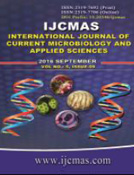


 National Academy of Agricultural Sciences (NAAS)
National Academy of Agricultural Sciences (NAAS)

|
PRINT ISSN : 2319-7692
Online ISSN : 2319-7706 Issues : 12 per year Publisher : Excellent Publishers Email : editorijcmas@gmail.com / submit@ijcmas.com Editor-in-chief: Dr.M.Prakash Index Copernicus ICV 2018: 95.39 NAAS RATING 2020: 5.38 |
The purpose of this review is to shed light on the metabolic profile of xylitol, xylitol production ability of yeast and significant application of xylitol in bioprocessing industry. Quite a lot of parameters influence Xylitol production. Optimized substrate concentration, carbon source, inoculum, aeration, temperature, pH and nitrogen supply are an essential concern. Chemical and enzymatic hydrolysis performs a crucial role in the creation of precursor xylose from agricultural biomass. And it is modified to xylitol predominantly by way of yeast stress. The most customarily used practices are Hydrolysis below acidic which are subjected to quite a lot of procedure parameters. A detoxing process is carried out as many fermentation approach inhibitors are produced for the duration of chemical hydrolysis that decreases xylitol creation. Hemicellulose, which is the second most plentiful polysaccharide in the atmosphere after cellulose, is degraded into xylitol via yeast. Hemicellulose has been successfully converted into fermentable ingredients by the continuous efforts by researchers in the last two decades. Hemicellulose has been efficiently changed into fermentable ingredients by way of the continuous efforts by using researchers in the last two decades. Hemicellulose is probably degraded into fermentable sugars and its conversion into price added products opens up a substantial area of purposes of xylitol in meals production.
 |
 |
 |
 |
 |